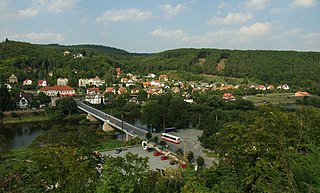
Mnichovo Hradiště is a town in Mladá Boleslav District in the Central Bohemian Region of the Czech Republic. It has about 9,000 inhabitants. The historic town centre is well preserved and is protected by law as an urban monument zone.

The Royal Castle in Warsaw is a state museum and a national historical monument, which formerly served as the official royal residence of several Polish monarchs. The personal offices of the king and the administrative offices of the royal court were located in the Castle from the 16th century until the final partition of Poland in 1795. Situated in the Castle Square, at the entrance to the Old Town, the Royal Castle holds a significant collection of Polish and European art.

Hořovice Castle is a castle in the town of Hořovice in the Central Bohemian Region of the Czech Republic.

Valašské Meziříčí is a town in Vsetín District in the Zlín Region of the Czech Republic. It has about 23,000 inhabitants. The historic town centre is well preserved and is protected by law as an urban monument zone.

Ujazdów Castle is a castle in the historic Ujazdów district, between Ujazdów Park and the Royal Baths Park, in Warsaw, Poland.

Kórnik Castle is a castle in the Polish town of Kórnik, which was constructed in the 14th century. The current neogothic design and remodeling was done in 1855 partly on the basis of architect Karl Friedrich Schinkel's plans for Tytus Działyński and the son Jan Kanty Działyński. After last member of Działyński family Jan Kanty Działyński's death, his brother-in-law Count Władysław Zamoyski received the castle in Jan's will. Shortly before his death in 1924, the childless count willed the castle, along with an extensive art collection and the Kórnik Arboretum to the Polish state.

Kostelec nad Černými lesy is a town in Prague-East District in the Central Bohemian Region of the Czech Republic. It has about 4,200 inhabitants. The historic town centre is well preserved and is protected by law as an urban monument zone.

Benešov nad Ploučnicí is a town in Děčín District in the Ústí nad Labem Region of the Czech Republic. It has about 3,600 inhabitants. The historic town centre with the castle complex is well preserved and is protected by law as an urban monument zone.

Nižbor is a municipality and village in Beroun District in the Central Bohemian Region of the Czech Republic. It has about 2,100 inhabitants.

Zalužany is a municipality and village in Příbram District in the Central Bohemian Region of the Czech Republic. It has about 300 inhabitants.

Toszek Castle is a Renaissance styled castle, located in Toszek (23 km away from Gliwice, Silesian Voivodeship in Poland.

Uniejów Castle is a 14th-century bishops' castle located on left bank of the Warta River in Uniejów, Łódź Voivodeship, Poland. It is considered one of the main places of interest in the town.

Kwidzyn Castle is a large brick Gothic castle in the town of Kwidzyn, Poland. The castle is modeled on the Gothic castles of the Teutonic Knights'.

Gołuchów Castle is an early Renaissance castle built in 1550-1560 for Rafał Leszczyński on a square plan and used as a defensive stronghold and residence. The castle is located in Gołuchów, Greater Poland Voivodeship, Poland.

Grodno Castle is a castle located in the southern parts of the Wałbrzych Mountains, on the Choina Mountain, standing to the left of the river Bystrzyca. The valley of this river, formerly known as the Silesian Valley, creates a natural boundary between the Owl Mountains and to the west of it the Wałbrzych Mountains. The castle is located in Zagórze Śląskie, Lower Silesian Voivodeship in Poland.

Liw Castle - a ruin of a Gothic ducal castle raised in the fifteenth century as a guarding stronghold in the town of Liw. The castle is located in Liw, Masovian Voivodeship; in Poland.

Sobieski's Castle in Oława is a Renaissance-Baroque style castle located in the site of a former Gothic castle. The original castle had been built by Duke Ludwik I built in the second half of the fourteenth century. It was the third castle structure in Oława, the first being the seat of the castellans, located in the south-east of the town. It remained an integral part of the town's defenses until the wars with the Hussites.

Castle of the Pomeranian Dukes - a medieval castle in the town of Szczecinek, for the Pomeranian Dukes. The southern wing of the castle was built in the early fourteenth century, in the location of a former Slavic gord. Due to reconstructions in the sixteenth, nineteenth and twentieth centuries the castle has not kept its original characteristics.

Sztum Castle is a castle located by Lake Zajezierskie, on Galla Anonima Street.

Osieczna Castle - built between 1890 and 1908, a Renaissance Revival castle located in Osieczna, Greater Poland Voivodeship in Poland.






















